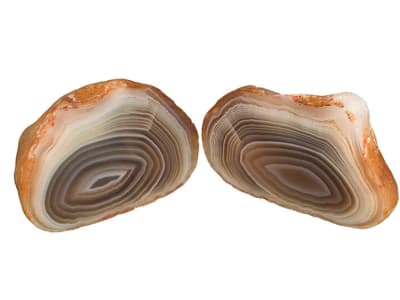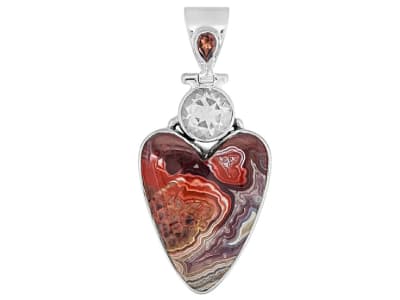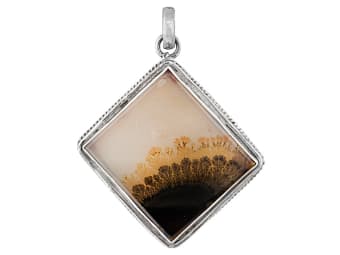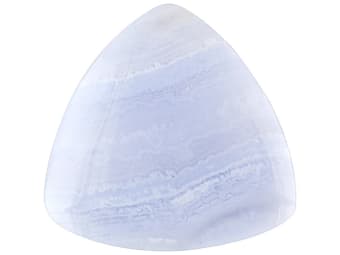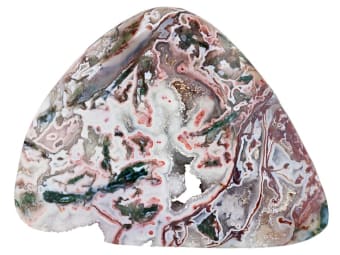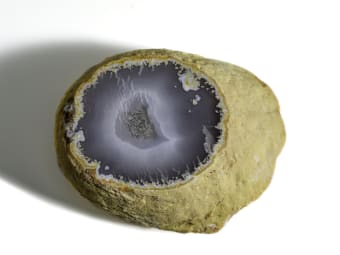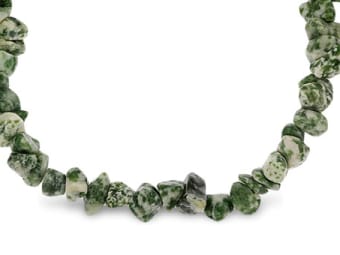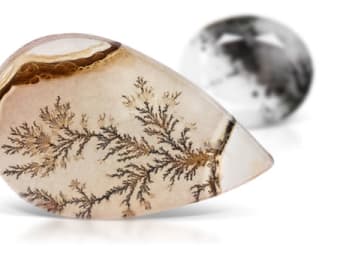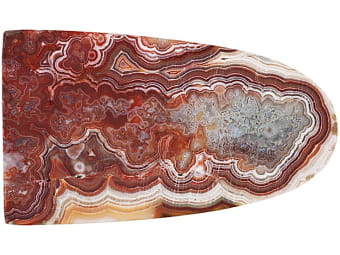Agate is the term used to describe the banded form of chalcedony. The term also covers translucent chalcedony varieties like moss agate, dendritic agate and phenomenal varieties like fire agate and iris agate. Agate has long been used to carve cameos, beads, cabochons, and decorative objects. Agate's name is derived from the site of its discovery, the river Achates (now Dirillo) in southwest Sicily.
General Information
LWUV: Inert
Agate Colors
-
 Bi-color
Bi-color -
 Black
Black -
 Blue
Blue -
 Brown
Brown -
 Gray
Gray -
 Green
Green -
 Multi-color
Multi-color -
 Orange
Orange -
 Pink
Pink -
 Purple
Purple -
 Red
Red -
 White
White -
 Yellow
Yellow
Countries of Origin
Papua New Guinea; Angola; Kazakhstan; Paraguay; Portugal; Iceland; Armenia; Greece; Austria; Mongolia; Mozambique; Morocco; Unknown; Panama; Brazil; Algeria; Iraq; Chile; Lesotho; Argentina; Hungary; Isle of Man; Japan; Bolivia (Plurinational State of); India; New Zealand; Canada; Turkey; Belgium; Namibia; Faroe Islands; Finland; Italy; South Africa; Antarctica; Georgia; Jamaica; Peru; Turkmenistan; Ethiopia; Germany; Yemen; Afghanistan; Russian Federation; Viet Nam; Czechia; United States of America; Madagascar; Thailand; United Kingdom of Great Britain and Northern Ireland; Costa Rica; Sweden; Malawi; China; Poland; Slovakia; Bulgaria; France; Croatia; Romania; Sri Lanka; Uruguay; Timor-Leste; Kenya; Switzerland; Spain; Cuba; Norway; Botswana; Congo (the Democratic Republic of the); Mexico; Zimbabwe; Australia; Tajikistan
History
The first written account of agate was by Greek philosopher and naturalist Theophrastus (ca. 315 BCE) who mentioned in his book De Lapidibus (On Stones) that agate was named after the Achates River in Greece where it was found. The earliest known carved agates come from Mesopotamia. Carved animals that date back to between 2000 BCE to 1001 BCE have been found. The Mycenaean used agate for seals, cylinders, and jewelry. The Pylos Combat Agate was found in a Bronze Age grave that dates to 1450 BCE near the Palace of Nestor in Pylos, Greece. The Greeks and Romans used agate for signet rings and tableware. Agate was used frequently throughout the Middle Ages for decorative objects and the cutting industry in Idar and Oberstein, Germany was developed to take advantage of the quartz resources in the surrounding area. Agate continues to be popular today and is a favorite stone for modern day lapidaries.
Care
Normal care is recommended for agate except for dyed stones should not be exposed to ultrasonics, heat, or harsh cleaners.
More About Agate
Agate plays an important role in folkloric medicine and was once believed to cure the stings of snakes or scorpions. Some Native American groups revered it as a stone that could strengthen the body and calm the spirit. The ancient Egyptians believed that agate quenched thirst and protected the wearer from lightning. The ancient Chinese gave agate credit for bringing luck and opportunity and for energizing one's chi.There are as many folkloric beliefs touting agate's "powers" as there are patterns to be found in the stones. Whatever you choose to believe, there is one certain thing: agate is a splendid stone!
Species/Variety
Picture Agate
Picture agate displays natural inclusions that formed within the stone in such a way as to create well-defined images. These images have a natural, life-like, picturesque appearance and make picture agate a treasured stone among gemstone lapidaries.
Blue Lace Agate
Blue lace agate comes from the Republic of Namibia and Kenya and is known for its powder blue coloring and white parallel wavy bands that resemble lace.
Fortification or Banded Agate
Fortification or Banded Agates have nearly parallel alternating bands of color and is what most people think of as Agate. The most well-known varieties are Blue Lace Agate, Botswana Agate, and Laguna Agate.
Plume Agate
Plume agates gets their name from its mineral inclusions that resemble feathers or billowy clouds of smoke. The best-known varieties of plume agate are Bloody Basin, Flame Plume, and Graveyard Point Plume agate.
Moss or Tube Agate
Moss and tube agates have inclusions that look like moss or enter connecting tubes. Some of the best-known varieties of moss and tube agates are Golden Moss, Indian Green Moss, Horse Canyon, and Rooster Tail agate.
Optical Phenomena
Iris Agate
A semitransparent to translucent member of the chalcedony species, iris agate is a phenomenal variety exhibiting an iridescent rainbow-like range of colors throughout the stone. It is highly prized by collectors and designers.
Fire Agate
Fire Agate is one of those gems whose beauty and appeal is hard to describe with mere words. A phenomenal gem, it is an opaque variety of chalcedony that exhibits a colorful iridescence. The iridescence is caused by layers of silica and iron oxides, which interfere with the passage of light. Diffraction causes the colorful metallic hues that make this gemstone a favorite of collectors. Its brown body color is also a result of the iron oxide content.
Inclusions
Enhydro Agate
Enhydro agate is agate that has water in the central cavity.
Moss Agate
Moss agate is a variety of chalcedony with contrasting white and green moss-like patterns. Its green coloration comes from a mineral called chlorite, while the reds and browns come from manganese oxide or the oxidation of iron hornblende. Moss agate is generally cut into thin slabs and polished to best display its natural patterns. Often moss agate cabochons are used in distinctive jewelry designs.
Dendritic Agate
This agate variety is termed "dendritic" due to its internal collection of dendrites. Dendrites are fern-like inclusions of iron, manganese, or other metallic oxides that create bold patterns within the gem. Typically, dendritic agates are cut into slabs to best exhibit nature's artwork. As you might guess, these pieces are one-of-a-kinds, as no two dendritic patterns are exactly the same.
Sagenitic Agate
Sagenitic agate has networks of needle like minerals, embedded secondary crystals or crystal replacements. The term Sagenite comes from the Latin word sagena which translates to “large net”. Some of the best known sagenitic agates are Trent agate and Crazy Lace agate.

